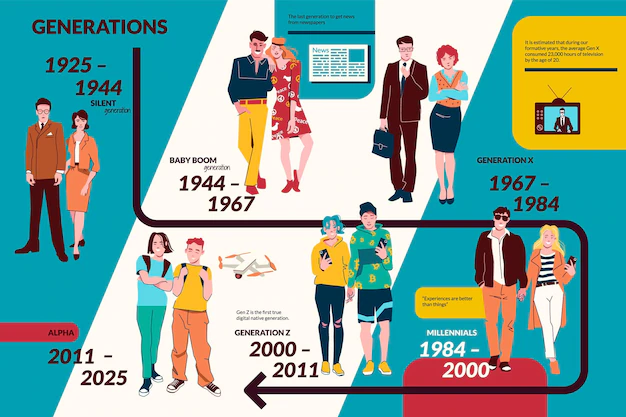Unraveling the Generational Chart and their Defining Characteristics
Creating a generations chart involves mapping out the various generational cohorts that span different periods in history, each characterized by unique experiences, values, and societal influences. These generations, often defined by researchers and sociologists, offer insight into how individuals from different age groups perceive the world, interact, and contribute to society. Here’s an overview of some prominent generations and their defining characteristics.

Page Contents
Unraveling the Generational Chart and their Defining Characteristics
- Traditionalists/Silent Generation (born roughly between 1928-1945): This generation grew up during the Great Depression and World War II. They are known for their strong work ethic, resilience, and loyalty. Traditionalists typically value hierarchy, conformity, and stability.
- Baby Boomers (born between 1946-1964): Coming of age during an era of economic prosperity and social change, Baby Boomers were influential in cultural revolutions such as civil rights movements and anti-war protests. They are associated with a focus on career advancement, idealism, and optimism.
- Generation X (born between 1965-1980): Shaped by economic uncertainty, globalization, and the rise of technology, Generation X witnessed the advent of personal computers and the internet. They are often characterized by independence, adaptability, skepticism, and a work-life balance.
- Millennials/Generation Y (born between 1981-1996): Millennials grew up amid rapid technological advancements, globalization, and economic volatility. They value diversity, innovation, social causes, and seek a sense of purpose in their work. They are known for their tech-savviness and inclination towards collaboration.
- Generation Z (born between 1997-2012): Also known as digital natives, Generation Z came of age in an era dominated by smartphones, social media, and connectivity. They are characterized by their entrepreneurial spirit, environmental consciousness, and a preference for authenticity and inclusivity.
- Generation Alpha (born from 2013 onwards): The newest generation is growing up in an increasingly digital and connected world. Their upbringing is heavily influenced by technology, AI, and global interconnectivity. It’s too early to define their characteristics fully, but they are likely to be tech-native, adaptive, and globally aware.
Brief History
The concept of categorizing generations based on shared experiences and cultural influences has a history rooted in sociological and demographic studies. The idea gained prominence in the 20th century as researchers and demographers observed distinct societal shifts and cultural changes across different periods.
Sociologist Karl Mannheim introduced the concept of generational theory in the 1920s, emphasizing the impact of historical events on shaping cohorts’ values and attitudes. Over time, historians, sociologists, and marketers further refined these generational categories, identifying common characteristics and behaviors that defined each group, leading to the creation of generations charts as a tool to understand societal trends, preferences, and generational dynamics.
Comprehension on Generational Chart
Comprehension on the traits and behaviors associated with each generation is crucial for businesses, policymakers, marketers, and HR professionals. It helps tailor strategies for communication, marketing, product development, and employee engagement to cater to the specific preferences and needs of different age groups.
Guide to Apprehending Behavioral Cohorts
Generations charts serve as a guide to apprehending the diversity of perspectives and behaviors across age cohorts. They facilitate meaningful discussions on how historical events, technological advancements, and societal changes shape each generation’s worldview, attitudes, and its contributions to society.
Conclusion
In conclusion, generations charts offer a valuable framework for comprehending the nuances of various generations, aiding in fostering better communication, collaboration, and knowing among individuals of different age groups in workplaces, communities, and society at large.
A generations chart provides an overview of distinct generational cohorts, offering insights into their defining characteristics, values, and societal influences, facilitating understanding and collaboration across different age groups in various contexts.







